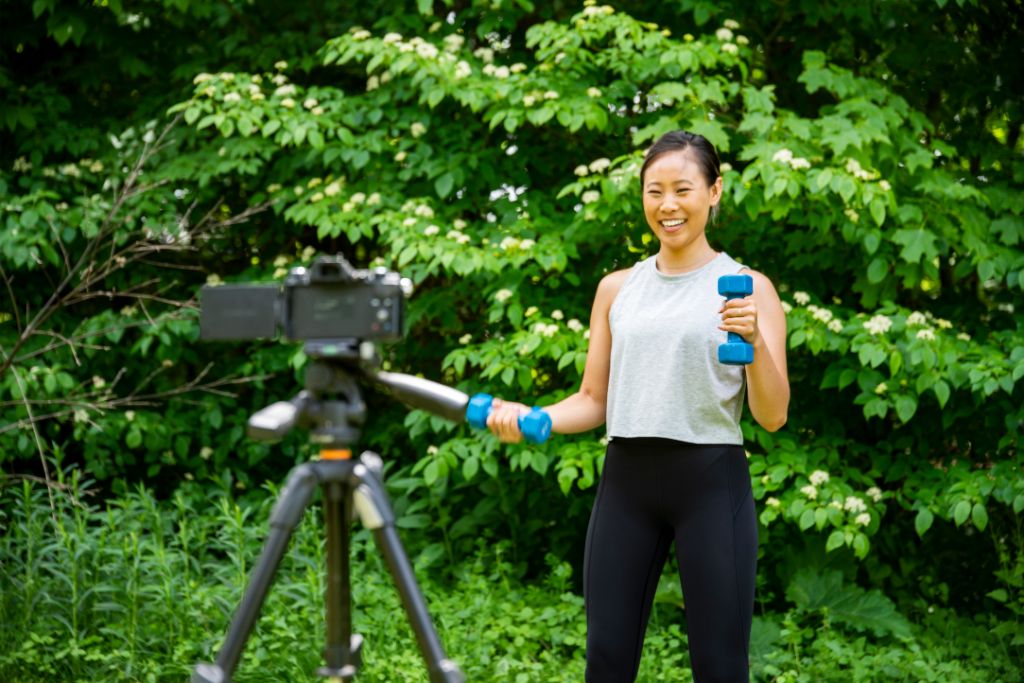Mastering Social Media A Guide For Personal Fitness Trainers

Hey, ace fitness trainer! Are you struggling with social media? You’re not alone. The digital realm can be a maze. But fear not! This guide is your torch.
It’ll turn you into a social media whizz, amplify your online visibility, and transform your followers into clients. Let’s dive in!
Let’s unravel the power of this mighty marketing beast together.
Table of Contents [show]
Understanding the Power of Social Media for Fitness Trainers
As a fitness trainer, you’ve got to understand that social media isn’t just about posting selfies. It’s a powerful tool that can truly transform your career.
It allows you to reach out and engage with potential clients, establish your brand, and promote your services. It’s all about leveraging influencer marketing and mastering digital advertising strategies.
Imagine partnering with an influencer who has a massive following of fitness enthusiasts. They could share your workout routines or health tips on their platforms, exposing you to an audience interested in your offer. That’s the power of influencer marketing.
Then there are digital advertising strategies – think Facebook Ads or Instagram-sponsored posts. These tools allow you to target ads specifically to people needing your services. For instance, someone searching for local gym memberships might see your ad on their feed.
So don’t underestimate social media’s role in propelling your career forward. When used strategically, it becomes more than just a platform for showcasing before-and-after photos—it becomes a springboard for success.
Choosing the Right Social Media Platforms
Navigating the social media landscape can be daunting, but don’t worry. We’ll guide you through it. You’ll get an overview of popular platforms and learn how to identify which ones your target audience regularly uses.
It’s not just about being on social media. It’s about being where your potential clients are and engaging them effectively, so let’s dive in and find the perfect platform for you as a fitness trainer.
Overview of popular platforms
Let’s dive into an overview of popular platforms that’ll boost your visibility as a personal fitness trainer. Understanding platform algorithms and audience demographics is key to your success.
With its visually-driven interface, Instagram is great for showcasing workout routines and client progress. Its algorithm favors high-engagement Content, so ensure you interact with followers regularly.
Facebook has a broader demographic range but prioritizes meaningful interactions in its algorithm. Sharing valuable health tips or engaging in fitness challenges could work well here.
LinkedIn targets professionals seeking lifestyle balance; articles on workplace wellness may gain traction here.
YouTube’s vast user base loves ‘How-to’ workout videos, thanks to its unique algorithm favoring watch time over views.
Identifying your target audience
Identifying your target audience is crucial. It’ll help you tailor Content that resonates with them and, ultimately, increase your client base. You need to understand the audience demographics well. Are they millennials seeking fitness inspiration or middle-aged individuals looking for health-focused workouts? This data will guide your content creation.
Moreover, brand positioning comes into play. You’re not just a fitness trainer; you’re a mentor, a motivator. Position yourself in the market accordingly – differentiate from competitors by highlighting what makes you unique. Do you specialize in weight loss programs or high-intensity training?
Creating a Strong Online Presence
Personal fitness trainers must create a robust online presence to attract and engage potential clients. Online branding strategies can play a vital role, allowing you to put your unique spin on fitness training and stand apart from the crowd.
Think about what makes you distinctive. Are you an expert in HIIT workouts or weightlifting? Do you specialize in postnatal recovery or sports injury rehab? Use these specialisms to shape your online brand, ensuring consistency across all platforms.
Profile optimization techniques are also critical. It would be best if you were easy to find, so use relevant keywords in your bio and throughout your posts. Ensure your contact info is up-to-date, too – if potential clients can’t reach out quickly, they might move on.
Engagement is also key – respond to comments, share useful Content, and show appreciation for client success stories. This helps build a community around your brand that’ll keep people returning.
Developing Engaging Content
Developing engaging Content is crucial to building your online presence, as it helps attract and retain potential clients. As a personal fitness trainer, you must use visual storytelling and content scheduling effectively to reach your audience.
- Content Scheduling: It’s essential for you not only to create Content but also to schedule it properly. Consistency in posting can increase engagement rates and keep your followers interested.
- Visual Storytelling: Use images or videos in your posts that tell a story about fitness journeys, successful client transformations, or workout routines. This approach makes the posts more relatable and exciting.
- Quality over Quantity: Don’t focus on churning out numerous posts; instead, prioritize quality content that provides value to your audience.
- Engage with Your Followers: Reply promptly to comments or messages from followers; this interaction builds relationships with potential clients.
Using Social Media to Connect with Clients
As a fitness professional, it’s not enough to post compelling Content on your Social Media Platforms. You’ve got to engage with your followers and respond promptly to their comments and messages. This interaction builds trust and fosters a sense of community around your brand.
Let’s dive deeper into the art of engagement, exploring effective strategies for responding to feedback, answering queries, and keeping that valuable dialogue with your clients ongoing.
Engaging with followers
Engaging with followers isn’t just about posting Content; it’s crucial to interact and build relationships. Implement effective follower interaction strategies by putting personalized follower engagement at the core of your social media approach.
Here are three key ways to do this:
- Respond Promptly: When followers comment or message you, reply immediately. This shows that you value their input and time.
- Personalize Your Communication: Use their names, remember previous interactions, and make them feel seen and appreciated.
- Create Community: Encourage followers to interact with each other by creating a supportive online community around your brand.
Responding to comments and messages
Responding to comments and messages isn’t just polite. It’s a pivotal way to show your followers their voices are heard and valued. It’s also essential to handle criticism gracefully; your reaction can turn a potentially harmful situation into a chance for growth. Remember, comment etiquette is crucial.
This table provides some guidelines:
| Situation | Appropriate Response |
|---|---|
| Positive feedback | Thank them and express gratitude |
| Constructive criticism | Acknowledge the point, thank them for their insight, and consider it |
| Negative feedback without substance | Politely ask for more details to understand their viewpoint better |
| Personal attack | Stay professional, and don’t engage negatively |
| Off-topic comments | Kindly steer the conversation back on track |
Growing Your Follower Base
You’re ready to take your social media presence to the next level.
Well, it’s time to dive into the power of hashtags and keywords, which can significantly boost your visibility among potential clients.
We’ll also explore collaborations and partnerships, two impactful strategies that can expand your reach within the fitness industry and foster a sense of community around your brand.
Incorporating relevant hashtags and keywords in your posts is crucial to increase social media visibility. This is known as hashtag strategy and keyword optimization, both vital for your online growth as a personal fitness trainer.
Below, you’ll find a helpful table that shows optimal ways of using these tools:
| Social Media Platform | Hashtag Strategy | Keyword Optimization | |
|---|---|---|---|
| Use popular, relevant fitness hashtags like #FitLife | #FitnessGoals | Incorporate keywords in captions, bio, and alt text | |
| Limit to 2-3 relevant hashtags per tweet | Include keywords in tweets and profile description | ||
| Less is more; one or two specific hashtags are enough | Optimize post descriptions, headlines, and about section | ||
| Use industry-specific hashtags like #PersonalTraining | #FitnessIndustry | Incorporate keywords into posts, headlines, summaries |
Collaborations and partnerships
Collaborations and partnerships are a great way to reach a wider audience and build credibility in the industry. To leverage this, here are four steps to follow:
- Identify Influencers: Be selective; choose influencers who align with your brand ethos and have an engaged audience.
- Create Mutual Benefits: Draft Cross Promotion Strategies where both parties benefit equally from the collaboration.
- Content Sharing: Share each other’s Content on social platforms, enhancing visibility among multiple audiences.
- Influencer Partnerships: Collaborate for live sessions, webinars, or co-develop workout plans.
Converting Followers into Clients
Turning your social media followers into clients isn’t as challenging as you think. It’s all about strategy and understanding the power of two crucial tools: Influencer Marketing and Scheduling Posts.
You’ve got an audience that admires your fitness journey. Now, it’s time to leverage that. Influencer marketing isn’t just for celebrities; even micro-influencers in the fitness industry can spark massive engagement. Collaborate with these influencers, let them share their experiences with your services, and watch how fast their followers become your clients.
Scheduling posts also plays a key role in this conversion process. You can’t afford to be random or inconsistent if you’re serious about converting followers into clients. Know when your audience is most active online and schedule your posts to hit those peak times. Regularly share informative Content such as workout tips, meal plans, and success stories – things that add value and keep you at the forefront of their minds.
Measuring Your Success
You’ll need to track your progress and evaluate your efforts to truly understand your strategies’ impact. Success metrics are the key indicators to determine whether your marketing plans work. Analytics tools, on the other hand, provide you with the raw data that these metrics interpret.
Here’s a simple table showing how these work together:
| Success Metrics | Analytics Tools | |
|---|---|---|
| What they do | They measure specific goals in your social media strategy. | They collect raw data from various sources (likes, shares, comments, etc.) |
| Example | Increase in client bookings. | Facebook Insights, Instagram Insights. |
| Why it matters | It helps you know what’s working and what needs improvement. | It provides insights into the behavior patterns of followers. |
Remember, don’t rely on vanity metrics like follower count or likes, but focus more on engagement rates and conversion ratios. Don’t be afraid to tweak things as needed; testing different approaches is part of mastering anything.
BONUS
Take your fitness training business to new heights with OnlySocial’s essential Post Planning and Scheduling function. Seamlessly plan and schedule your posts across all social networks, ensuring consistent and strategic content delivery. With unlimited posting and the ability to manage unlimited social profiles, you can expand your online presence without limitations. Don’t miss out on optimizing your social media strategy. Sign up for a commitment-free 7-day trial today.
Frequently Asked Questions
Bear in mind privacy policies are crucial when posting client info. Respect Copyrighted Content; avoid using others’ materials without their consent or proper attribution. Legal issues on social media platforms may impact your fitness business.
To align your social media with your brand, create Content that mirrors your fitness philosophy. Engage your audience with posts they’ll connect with. Showcase your expertise. Promote a healthy lifestyle.
Set aside 60 minutes each day for your social media. This gives you space for crafting solid content strategies. You can also study engagement metrics. It’s a surefire way to boost your online presence!
Have you got negative feedback on social media? Don’t sweat it!
First off, take a deep breath and strategize. Yes, it would be best to have a game plan for this. Remember, managing your online image is crucial.
Quick response? Check. Professional tone? Absolutely. Positive attitude? No doubt.
Negative comments are harsh, but they’re also a golden opportunity.
See it as a chance to evolve.
Criticism can be your growth ladder. After all, you’re a fitness trainer, and growth is your mantra.
Are you offering online fitness training? You’re at risk. Online liability risks, to be exact. It’s essential to protect yourself. How? With insurance coverage. It must be tailored to your unique risks. This ensures your business stays safe.





